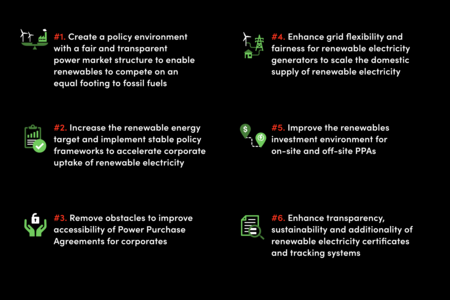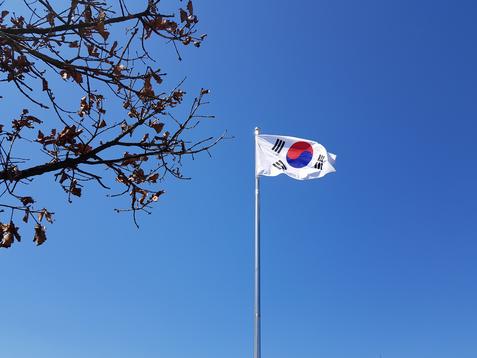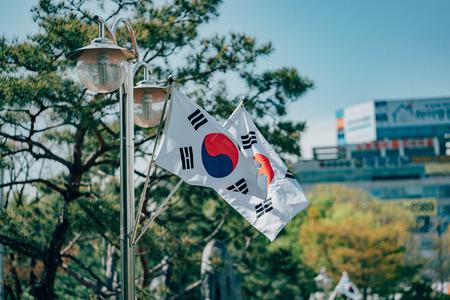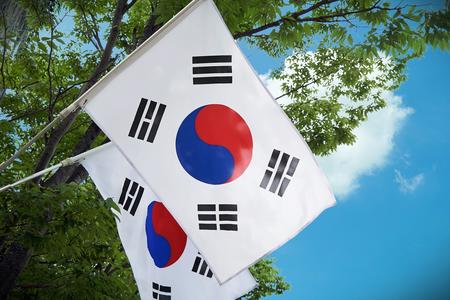Since the launch of the South Korean RE100 Localised Policy Messages (LPM) in March 2023, ambition and action on renewable electricity has gained momentum. It’s promising to see progress on the LPMs from the government and a welcome sign for the RE100 member network – there are over 30 South Korean headquartered RE100 companies, all aiming to achieve 100% renewable electricity before 2050.
Despite the progress, more must be done to increase access to renewable electricity in South Korea. It’s regularly cited by our members as one of the most challenging markets in which to procure renewables. RE100 members in South Korea get just 2% of their electricity from renewables, compared to 32% in China, 26% in Singapore, and 15% in Japan.
We’re calling on decision-makers in South Korea to use our Localised Policy Messages as a guide to unlock further progress on the energy transition – helping to make renewables more accessible and affordable. Here’s an update on what ‘live moments’ exist to increase policy progress in Korea, what recent positive signals could be built upon by policymakers, and which of our LPMs have not yet been carried forward.

Three live moments for further policy progress
- The ‘10th Basic Energy Plan’, released at the start of 2023, reduced South Korea's 2030 renewable energy target from 30.2% to 21.6%. In doing so, the government sent a negative signal to the market and took a step back on the path to a zero-carbon grid.
The 2023 ‘Carbon Neutrality and Green Growth Plan’ from the government has now increased this target to “21.6% + Alpha”. The use of “Alpha” here denotes a number higher than 21.6%, but in reality, “Alpha” could mean only a +0.1% increase on 21.6%. As LPM 2a recommends, the government must bring clarity to this situation and increase its renewable electricity target beyond 21.6%. This will incentivise investment in wind and solar and help meet the country’s large corporate demand for renewables.
- We are pleased to see the government taking action against LPM 3b to ‘remove unfair contractual obligations’ that existed with Power Purchase Agreements (PPAs), by addressing the double charging issue. Previously, corporations who wanted to sign PPA contracts had to face transmission and distribution cost for both their existing electricity supply and the supply from the newly signed PPA. This was removed on the 1 January 2023. However, at the same time, Korea Electric Power Corporation (KEPCO), South Korea's largest electric utility, is now proposing the introduction of a new ‘Renewable Energy Users’ Electricity Rate (RE users’)’. This rate will apply to corporations that have signed either trilateral or direct PPAs for a portion of their electricity use and then purchase the remainder of their electricity from KEPCO.
This new pricing plan imposes a base rate that can be up to 1.5x higher than the standard industrial electricity rate onto corporates, making renewable PPA prices uncompetitive with fossil fuel prices. With the Ministry of Trade, Industry and Energy (MOTIE) and KEPCO still deciding whether to implement the RE users’ plan, we are calling for this scheme to be reconsidered. This plan risks making PPAs more costly and therefore less accessible to corporates. - ‘The Distributed Energy Special Act’ is likely to be approved by the government this year. Within this bill, MOTIE is continuing its gradual adjustments of the Renewable Portfolio Standards (RPS), a regulatory mandate on generators to supply a specified minimum percentage of customer demand with renewables. MOTIE is expected to announce a reduction of the RPS expected of generators, as they indicated doing so in the ‘10th Basic Energy Plan’.
Reducing the percentage expected of generators for the wider market is motivated by the desire to increase the availability of renewables for the RE100 market. But with a limited supply of renewables available, reducing the RPS only shifts who can receive this limited supply. The root cause, a lack of supply, is not addressed. In line with LPM 4a the focus should instead be on expanding supply equally, not reducing the RPS which removes the impetus on generators to develop new renewable projects and runs counter to meeting the growing demand for renewables from the South Korean RE100 companies.
Recent positive policy signals
The ‘Carbon Neutrality and Green Growth Plan’ speaks to LPM 1a by stating that renewables prices must shift to ensure they reflect the true cost of renewable electricity. The plan emphasises the need for “a principle of electricity prices to reflect the actual cost”. In a fair market, renewables outperform fossil fuels time and again and so we're pleased to see the government recognising the needs outlined in LPM 1. We encourage them to go one step further and specify how they will address the pricing gap to ensure the affordability of renewables that RE100 members and beyond are demanding.
The plan also acknowledges the need for a more flexible grid as outlined in LPM 4b, stating that “for the stability of electricity a smarter and more flexible grid should be set”. The government must now take steps to promote investment that increases grid flexibility for renewable electricity generators. To account for the variability of renewables the grid must have a strong transmission and distribution network, allowing for multiple generation and consumption points.
We’re pleased to see that the Korea Energy Agency is acting on the needs outlined in LPM 6c. According to the ‘2023 Plan for Green Premium Auctions’, announced by Korea Energy Agency on 2 February, the frequency of its ‘Green Premium’ auctions have been increased from two per year to three per year. Corporations now have more space to adjust the Green Premium price on top of their electricity bills. Yet more work is needed from the government on Green Premiums, as outlined in the rest of our LPM 6, in order to add more renewables to the grid.
No progress from decision-makers
Policy reform is urgently needed to unlock South Korea’s net zero future. The policy barriers outlined above on unambitious national renewables targets, the new RE users’ plan, RPS reductions, the renewables pricing gap, grid inflexibility and Green Premiums are areas where we can see positive movements being made, in line with what businesses are asking for from the government.
This is however only part of the picture and significant barriers remain that are holding back the development of renewable electricity projects in South Korea. As demonstrated by the remaining LPMs not mentioned above. Businesses are calling for more action but so far there has been no progress, or movement in the wrong direction, from decision-makers on the remaining LPMs. These LPMs address the expansion of PPAs, ensuring fair network usage fees, driving better investment in renewables, and improving the use of Green Premiums (LPM 2b, 3a, 5b, 5c, 6a, 6b and 6d). You can read them in full here.
We’re calling for further action and ambition from the South Korean government, to increase the accessibility and affordability of renewables, and to meet demand from over 30 South Korean headquartered RE100 companies, all aiming to achieve 100% renewable electricity before 2050. Now is the time to act.



